Table of Contents
Japanese food is popular worldwide. To truly experience the diverse flavors and regional specialties of Japanese food, it’s important to eat like a local. From street food stalls to traditional izakaya pubs, there’s no shortage of delicious and authentic Japanese food options to try throughout the country. By embracing the local Japanese food culture and dining etiquette, travelers can immerse themselves in Japan’s rich culinary heritage and discover some of the best dishes the country has to offer. So, let’s explore some of the top tips for eating Japanese food like a local one, and savor the best of its cuisine.
Most popular Japanese food – Sushi
When you think of Japanese food, what’s the first thing that comes to your mind? For many people, it’s probably sushi. And it’s no wonder why – sushi is one of the most iconic and beloved Japanese dishes out there. But what exactly is sushi, and why is it so popular? Well, at its most basic, sushi is a dish of small pieces of raw fish on top of a small ball of sticky rice. But that’s just scratching the surface. There are actually many different types of sushi, each with its own unique flavors and preparations. From the simplicity of nigiri sushi to the creativity of maki sushi, there’s a lot to explore when it comes to this delicious and fascinating cuisine.
Nigiri Sushi: Simple and Traditional
Ah, nigiri sushi! This is probably the most classic and recognizable type of sushi out there. Nigiri sushi is simply a small ball of vinegared rice with a slice of raw fish, usually tuna or salmon. It’s a simple yet elegant dish that really lets the flavors of the fish shine through. The quality of the fish is crucial for a good nigiri sushi – it should be fresh, tender, and melt-in-your-mouth delicious. Some sushi chefs will even brush a tiny bit of soy sauce onto the fish before serving to enhance the flavor. When you’re at a sushi restaurant, ordering a plate of nigiri sushi is a great way to get a taste of the traditional and authentic side of Japanese cuisine.
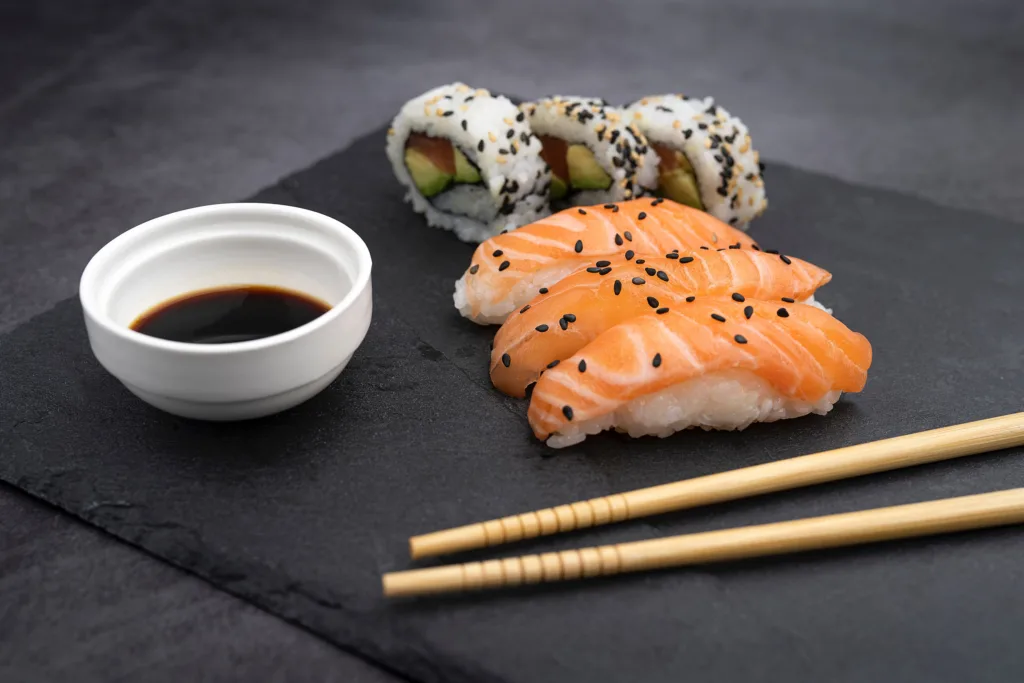
Maki Sushi: The Creative Side of Sushi
Maki sushi is where things get a little more creative! Unlike nigiri sushi, which is just a slice of raw fish on top of rice, maki sushi is a roll of rice and other ingredients wrapped in seaweed, or nori. The possibilities for fillings are endless – anything from avocado and cucumber to crab meat and spicy mayo. It’s a fun and delicious way to enjoy sushi, and the variety of ingredients means there’s something for everyone. Whether you’re a sushi purist or love to try new flavor combinations, maki sushi is definitely worth exploring. Plus, it’s just really fun to eat – who doesn’t love a good sushi roll?
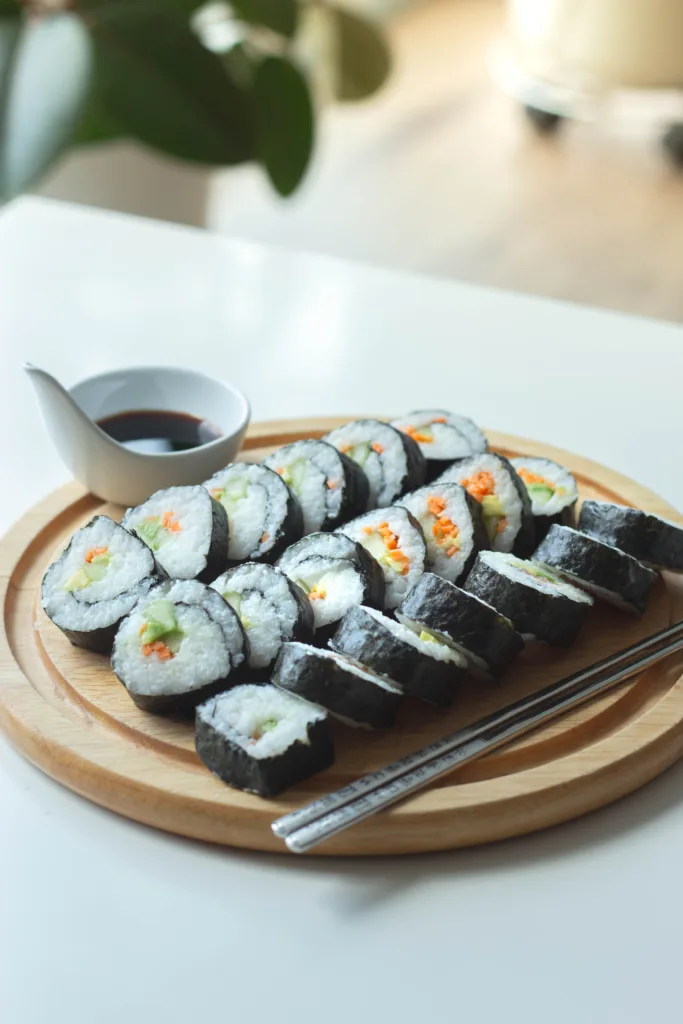
Chirashi Sushi: A Bowl Full of Freshness
Chirashi sushi is a type of sushi they serve in a bowl, rather than rolled up or presented as individual pieces. It’s basically a bed of sushi rice with an assortment of fresh sashimi, vegetables, and other toppings. Chirashi sushi is a great option if you’re looking for something a little lighter than traditional sushi rolls or nigiri. It’s like a work of art in a bowl! If you’re a fan of fresh, high-quality sashimi, chirashi sushi is definitely something you should try. And since there are so many different types of fish and toppings, it’s a dish that you can enjoy over and over again.
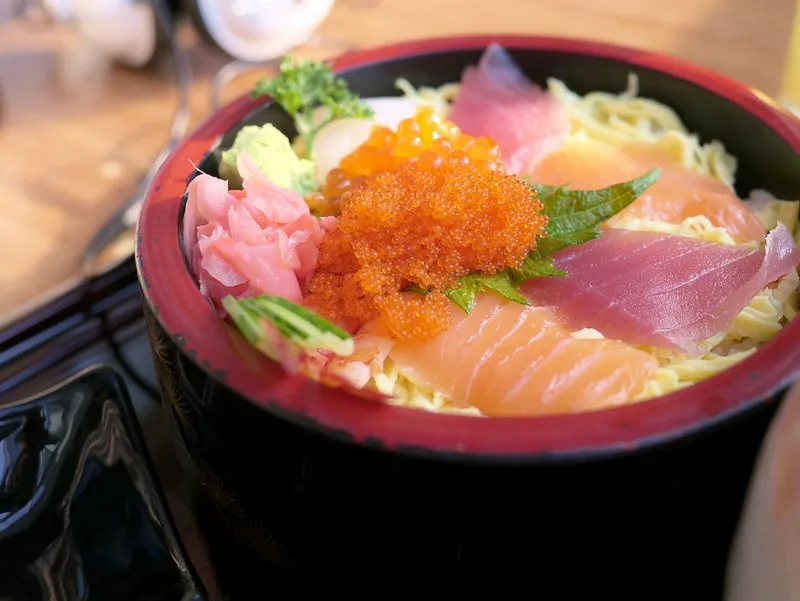
Where to Try Sushi in Tokyo, Osaka, and Kyoto
If you’re planning a trip to Japan and want to try some amazing sushi, you’re in luck! Tokyo, Osaka, and Kyoto are all home to some of the best sushi restaurants in the world. In Tokyo, you can’t go wrong with a visit to the famous Tsukiji fish market. There you’ll find tons of sushi stalls and restaurants serving up the freshest seafood imaginable. Another great spot in Tokyo is Sushi Saito. It has three Michelin stars and is widely popular as one of the best sushi restaurants in the city.
In Osaka, check out Endo Sushi, a beloved local spot that’s been serving up delicious sushi for over a century.
And in Kyoto, try out Izuju, a traditional sushi restaurant that’s been around since the 1700s. No matter which city you’re in, there are plenty of options for sushi lovers to choose from. Just be sure to make a reservation in advance, as many of the best sushi restaurants book up weeks or even months ahead of time!
Ramen
The dish usually consists of wheat noodles in a flavorful broth, topped with meat, vegetables, and other ingredients. But what really makes ramen special is the incredible variety of flavors and styles available. You can find everything from rich, pork-based tonkotsu ramen to spicy, seafood-based tantanmen ramen. And no matter what type of ramen you try, there’s always something comforting and satisfying about a big bowl of hot noodles on a cold day. If you’re visiting Japan, be sure to seek out some of the local ramen shops!
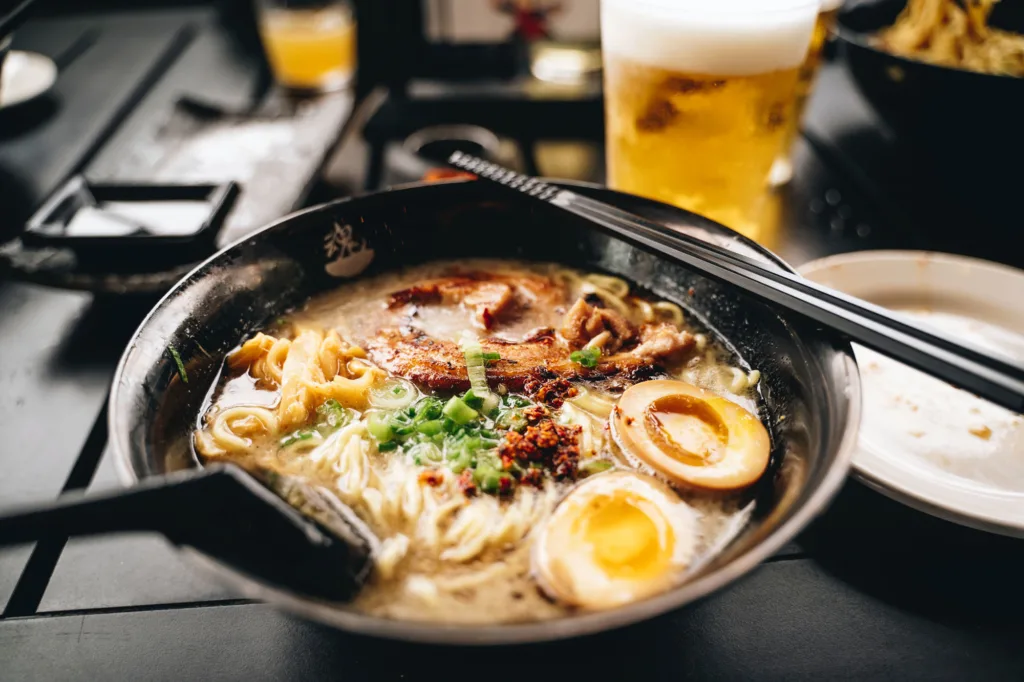
Shoyu Ramen: The Classic Soy Sauce Flavor
Shoyu ramen is one of the most classic and beloved types of ramen in Japan. They make broth from soy sauce, which gives it a rich, savory flavor that’s hard to resist. The noodles are usually on the thinner side, perfectly chewy and tender. Shoyu ramen they serve with toppings like sliced pork, bamboo shoots, green onions, and seaweed. It’s the perfect comfort food on a chilly day. The combination of salty, savory broth and tender noodles is just so satisfying. If you’re a fan of classic Japanese flavors, shoyu ramen is definitely something you should try. And even if you’ve never had ramen before, it’s a great place to start – it’s just so darn tasty!
Miso Ramen: The Umami-Rich Flavor
Miso ramen is another popular type of ramen that people love for its rich, umami flavor. They make broth from miso paste, which is a fermented soybean paste that adds a deep, complex flavor to the soup. The noodles used in miso ramen are typically thicker and chewier than those used in shoyu ramen. The toppings for miso ramen can vary but often include things like sliced pork, corn, and bean sprouts. The combination of salty miso broth, chewy noodles, and flavorful toppings creates a dish that’s just bursting with savory goodness. If you’re a fan of bold, complex flavors, miso ramen is definitely a must-try. It’s one of those dishes that’s just so comforting and satisfying – you’ll want to slurp up every last drop!
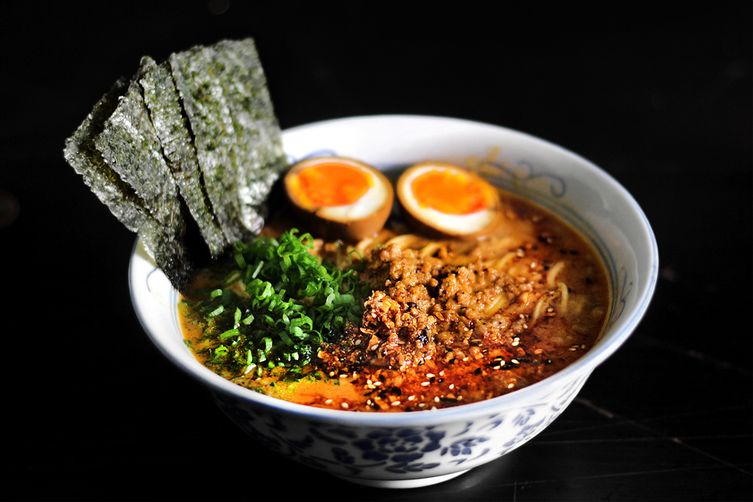
Tonkotsu Ramen: The Creamy Pork-Bone Broth Flavor
Tonkotsu ramen is a rich, hearty type of ramen that people know for its creamy, pork-bone broth. They make broth by boiling pork bones for hours until they release all their collagen. It creates a thick, creamy consistency that’s just full with flavor. The noodles they use in tonkotsu ramen are usually on the thicker side and are need to cook until they’re perfectly al dente. The toppings for tonkotsu ramen can vary, but often include things like sliced pork, green onions, and pickled ginger. One of the best things about tonkotsu ramen is how filling it is. It’s the kind of dish that will leave you feeling warm and satisfied for hours. If you’re a fan of rich, hearty soups, tonkotsu ramen is definitely something you should try. Prepare to become totally addicted to that creamy, savory broth!
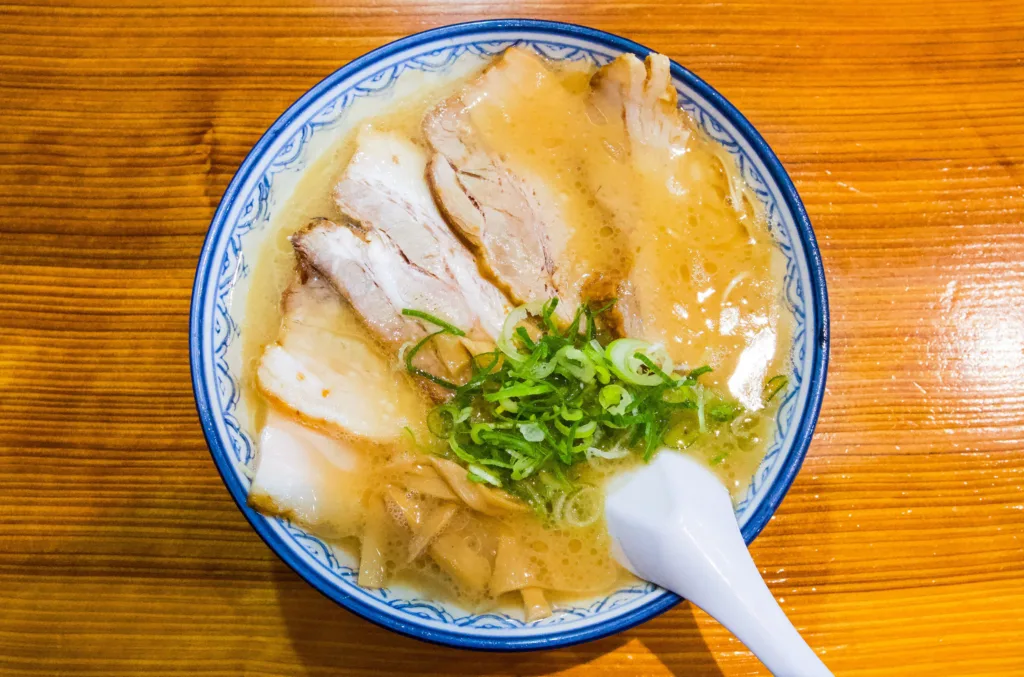
Where to Try Ramen in Tokyo, Osaka, and Kyoto
If you’re planning a trip to Japan and want to try some of the best ramen in the country, you’re in luck! Tokyo, Osaka, and Kyoto are all famous for their incredible ramen shops. There are so many options to choose from that you’re sure to find something you love. In Tokyo, some of the most popular ramen shops include Ichiran, where you can order customizable bowls of tonkotsu ramen. And Tsuta, which is the first ramen restaurant in the world to receive a Michelin star.
Osaka is famous for its thick, chewy noodles and rich, flavorful broth, with popular shops including Ippudo and Kinryu Ramen.
And in Kyoto, you’ll find more traditional, light, and delicate broths at places like Gogyo Ramen and Menya Inoichi. No matter where you go, you’re sure to find amazing ramen that will blow your mind. Prepare to wait in line, though!
Tempura
Tempura is a type of Japanese food everyone love, and it’s easy to see why! It’s essentially just a type of fried food, but the Japanese have really perfected the art of making it. The batter used to coat the food is incredibly light and crispy. Some of the most popular types of tempura include shrimp, squid, and various vegetables like sweet potato, eggplant, and zucchini. They serve tempura with a dipping sauce made from soy sauce, dashi, and mirin. Those add a salty-sweet flavor that perfectly complements the crispy fried coating. If you’re a fan of fried foods, you definitely need to try tempura at least once – it’s a true Japanese classic!
How they make Tempura: The Art of Deep-Frying
Making tempura is definitely an art form. It’s all about getting that perfect balance of light, crispy batter and perfectly cooked filling. The first step is to prepare the batter, which is usually made by combining wheat flour, egg, and ice-cold water. The key to making a great tempura batter is to keep everything as cold as possible. This ensures that the batter stays light and doesn’t absorb too much oil. Once the batter is ready, it’s time to start frying!
The fillings, whether it’s shrimp, vegetables, or other seafood, are usually coated in a light dusting of flour before being dipped into the batter. Then they’re gently lowered into a pot of hot oil and cooked until the batter is golden brown and crispy. The tempura is typically served hot and fresh, with a side of dipping sauce for added flavor. If you’re feeling adventurous, you can even try making tempura at home. Just be sure to keep everything nice and cold, and don’t overcook the filling!
Shrimp Tempura: The Most Popular Variety
If you’re a fan of tempura, then you’ve probably heard of shrimp tempura – it’s one of the most popular varieties of this delicious Japanese dish! Shrimp tempura is made by taking large, juicy shrimp and coating them in a light, crispy batter made from flour, egg, and ice-cold water. The shrimp are then deep-fried until the batter is golden brown and the shrimp is cooked to perfection. The result is a dish that’s both crunchy and tender, with a perfect balance of flavors and textures. Shrimp tempura is usually served as an appetizer or as part of a larger meal, and it’s often accompanied by a dipping sauce made from soy sauce, dashi, and mirin. Whether you’re a fan of seafood or just love the taste of crispy fried food, shrimp tempura is definitely a dish that’s worth trying!
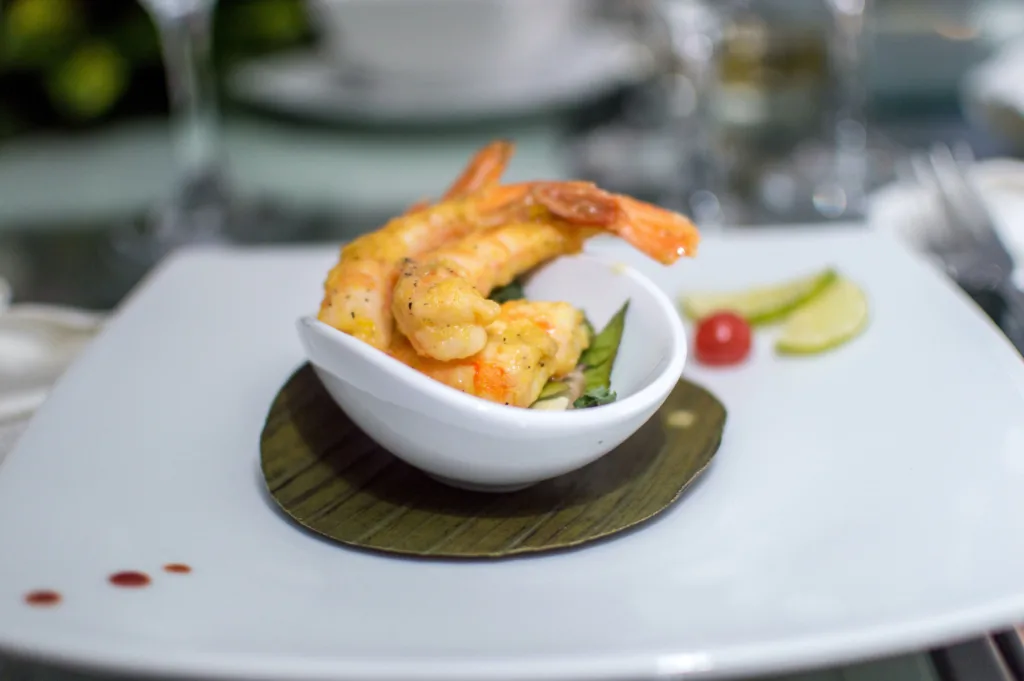
Vegetable Tempura: A Vegetarian Option
For all the vegetarians out there, vegetable tempura is a great option to try! This version of tempura is made by taking fresh vegetables like sweet potato, pumpkin, bell peppers, or broccoli and coating them in a light, crispy batter made from flour, egg, and ice-cold water. They deep fry the vegetables until the batter is golden brown and the veggies are cooked to perfection. The result is a dish that’s both colorful and flavorful, with a perfect balance of crunchy texture and savory taste. Vegetable tempura is a great option for those looking for a vegetarian-friendly meal or those who just want to add some more veggies to their diet in a delicious way. So next time you’re looking for a tasty appetizer or side dish, give vegetable tempura a try!
Where to Try Tempura in Tokyo, Osaka, and Kyoto
If you’re looking for some of the best places to try tempura in Japan, then Tokyo, Osaka, and Kyoto are places to be! In Tokyo, you can head to Tenichi, a restaurant that’s been serving up delicious tempura since 1930. For a more upscale experience, try Tempura Kondo, which has two Michelin stars and offers a variety of different tempura dishes. In Osaka, make sure to check out Kiji, a restaurant that’s been specializing in tempura for over 60 years. For a more modern take on the dish, try Tempura Matsui, which combines traditional tempura with French-style cuisine. And in Kyoto, make sure to stop by Yoshikawa Tempura. It is in a traditional Japanese house and offers a wide variety of tempura dishes using fresh, local ingredients. No matter which city you find yourself in, you’re sure to find some amazing tempura that will leave you wanting more!
Okonomiyaki
If you’re looking for a unique and delicious Japanese dish to try, then you have to check out Okonomiyaki! This savory pancake is a popular type of street Japanese food and they make by combining a batter of flour, eggs, and shredded cabbage with various toppings like sliced meat, seafood, and vegetables. The name “okonomiyaki” actually means “grilled as you like it”, which means that you can customize your pancake to your heart’s content. Once they mix the ingredients together, the pancake is cooked on a griddle and topped with a sweet and savory sauce, mayonnaise, and dried bonito flakes. It’s a dish that’s both hearty and flavorful and is definitely a must-try if you’re looking to explore the world of Japanese food.
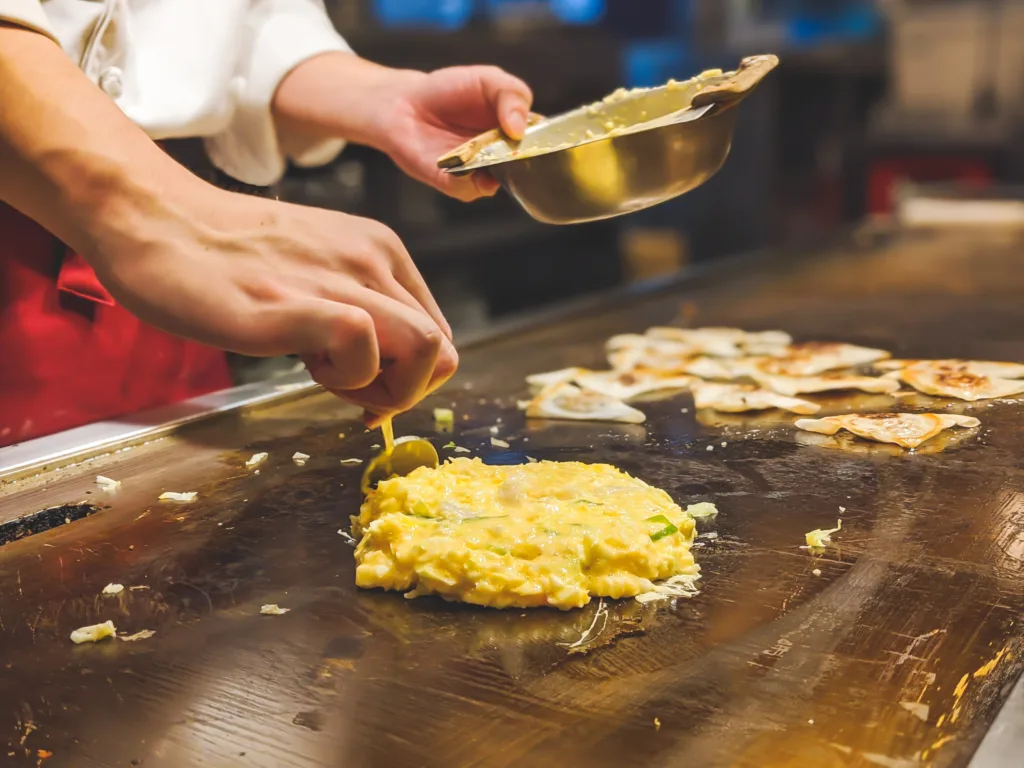
Hiroshima-Style Okonomiyaki: Layered and Filling
If you’re a fan of Okonomiyaki, then you have to try the Hiroshima-style version of this popular Japanese dish. This style of Okonomiyaki is layered and filling and they make them by stacking the ingredients on top of each other instead of mixing them together like in the traditional version. The bottom layer is made up of a batter of flour, eggs, and shredded cabbage, and is then topped with noodles, sliced meat or seafood, and even more cabbage. Once the ingredients are stacked, the pancake is flipped and cooked until everything is crispy and golden brown. Finally, it’s topped with sweet and savory sauce, mayonnaise, and dried bonito flakes. It’s a delicious and hearty dish that’s sure to satisfy any craving for comfort food
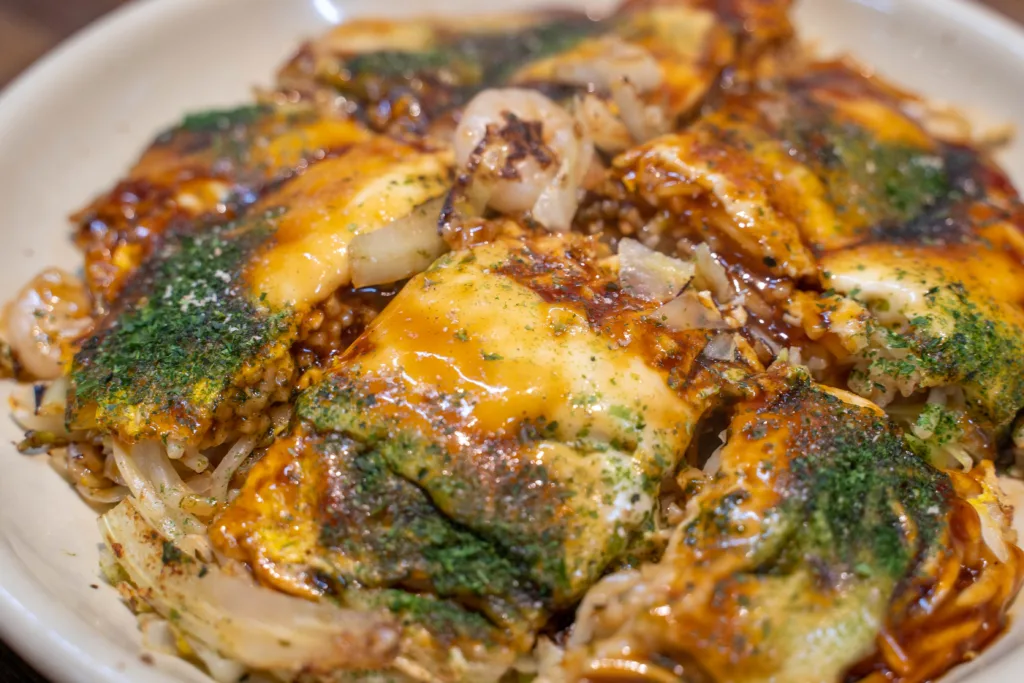
Osaka-Style Okonomiyaki: Mixed and Grilled
If you’re a fan of Okonomiyaki, then you have to try the Osaka-style version of this popular Japanese dish. This style of Okonomiyaki is mixed and grilled and is made by combining the batter of flour, eggs, and shredded cabbage with various ingredients like sliced meat, seafood, and vegetables. The mixture is then grilled on a flat iron plate until everything is crispy and golden brown. Unlike the Hiroshima-style version, all the ingredients are mixed together in one big pancake, making it easier to eat on the go. Once it’s done cooking, it’s topped with sweet and savory sauce, mayonnaise, and dried bonito flakes. It’s a delicious and filling dish that’s perfect for a quick snack or a full meal. If you’re in Osaka, make sure to check out the famous Dotonbori Street, where you’ll find plenty of restaurants serving up delicious Osaka-style Okonomiyaki!
Toppings and Sauces: Customize Your Own Okonomiyaki
One of the best things about Okonomiyaki is that you can customize it to your liking with a variety of toppings and sauces. Some of the most popular toppings include sliced pork belly, shrimp, squid, octopus, cheese, and even mochi. And when it comes to sauces, the classic Okonomiyaki sauce is a must, which is a combination of Worcestershire sauce, ketchup, soy sauce, and sugar. You can also add mayonnaise, which is a staple topping in Japan, as well as dried bonito flakes and aonori (dried seaweed flakes). You can mix and match your toppings and sauces to create your own unique flavor profile, which is one of the reasons why Okonomiyaki is such a beloved dish in Japan. So, next time you’re at an Okonomiyaki restaurant, don’t be afraid to get creative and add your own twist to this delicious dish!
Where to Try Okonomiyaki in Osaka and Hiroshima
If you’re looking to try some authentic Okonomiyaki, then Osaka and Hiroshima are two of the best cities to visit. In Osaka, one of the most popular spots is Okonomiyaki Chitose, which has been serving up delicious Okonomiyaki for over 70 years. They have a variety of options on their menu, including Osaka-style and Hiroshima-style Okonomiyaki. Another great spot in Osaka is Mizuno, popular for its unique and delicious toppings, such as scallops and squid.
As for Hiroshima, one of the most famous Okonomiyaki restaurants is Okonomi-mura, which is a multi-level building filled with different Okonomiyaki stalls. Here, you can try various styles of Okonomiyaki and customize it to your liking. Another popular spot is Hassei, which is near the Hiroshima Peace Memorial Park and is known for its Hiroshima-style Okonomiyaki. So, make sure to check out these spots if you’re in the area and get ready to indulge in some mouth-watering Okonomiyaki!
Matcha
Have you ever heard of Matcha? It’s a type of green tea that’s been around for centuries and is famous in Japan for its unique flavor and health benefits. Matcha is made from the same tea leaves as regular green tea. But it’s grown in a special way and then ground into a fine powder. This powder you then whisk into hot water to create a frothy and vibrant green tea. What sets Matcha apart is its distinct taste – it’s slightly bitter, yet also has a sweet and creamy flavor. Full of antioxidants, vitamins, and minerals, making it a healthy drink option. You can use match not only for drinking, but for various desserts like ice cream, cakes, and mochi. So, if you’re looking for a unique and healthy drink option, give Matcha a try!
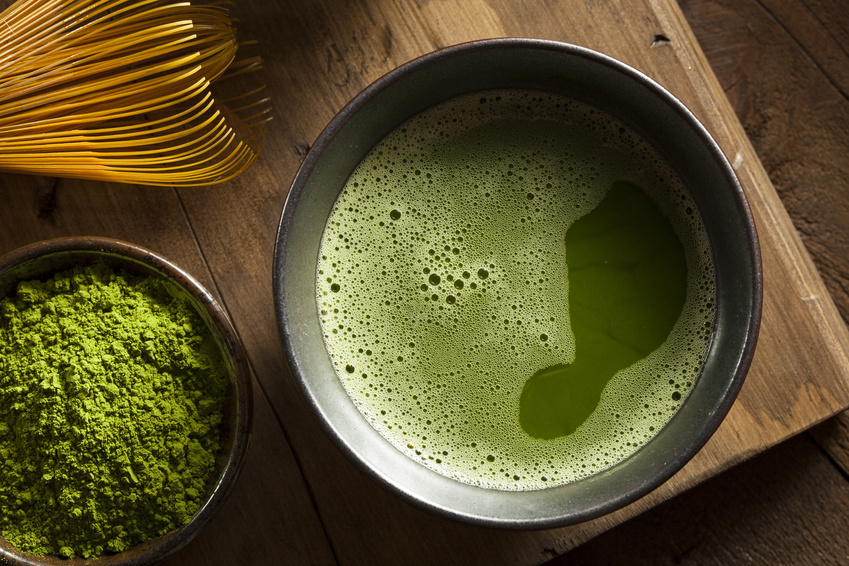
Matcha and Traditional Japanese Culture
Did you know that Matcha has a special place in traditional Japanese culture? Matcha has been a part of Japanese tea ceremonies for centuries and is considered a symbol of hospitality, harmony, and respect. In fact, the preparation and serving of Matcha is a ritual in itself, with specific steps and etiquette to follow. The tea ceremony is often in a traditional Japanese tea house and is a way to promote mindfulness, relaxation, and appreciation for the beauty of nature. They also use matcha in other traditional Japanese customs and celebrations, such as weddings and the New Year. So, if you want to experience a piece of Japanese culture and history, trying Matcha is a great way to start. Plus, it’s delicious and healthy too!
Matcha Desserts: A New Way to Enjoy Matcha
If you’re a fan of matcha, you’ll love the unique and delicious matcha desserts that Japan has to offer. From soft and creamy matcha ice cream to fluffy matcha cakes and delicate matcha mochi, there’s a dessert for everyone to enjoy. Matcha’s rich and earthy flavor pairs perfectly with sweet treats, creating a perfectly balanced dessert. If you’re looking for something a bit more unique, try a matcha latte or a matcha-flavored pastry.
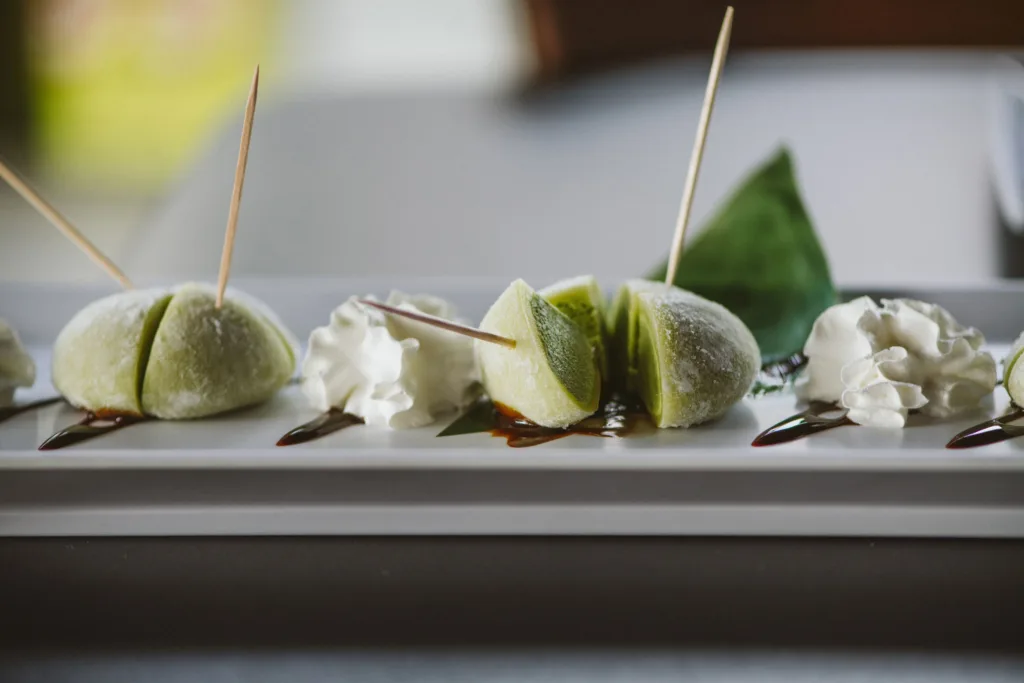
Where to Try Matcha in Tokyo and Kyoto
If you’re looking for the best places to try matcha in Japan, Tokyo, and Kyoto should be at the top of your list. In Tokyo, you can find many traditional tea houses and cafes that serve high-quality matcha. One popular spot is the Tsujiri tea house, which has been serving matcha for over 150 years. They offer a range of matcha drinks and desserts, including their famous matcha parfait. In Kyoto, you can explore the historic streets and visit traditional tea houses where you can experience a traditional Japanese tea ceremony. One must-visit spot is the Uji district, which is known for its high-quality matcha and is home to many tea houses and shops. Whether you’re looking for a traditional tea experience or modern matcha desserts, Tokyo and Kyoto have plenty of options to satisfy your matcha cravings.
Essentials for creating Japanese dishes at home
Essentials you should have in your pantry and kitchen. Here are some of the key ingredients and tools:
- Rice: Japanese cuisine relies heavily on rice, so having high-quality short-grain rice is essential. You will also need a rice cooker or a pot with a lid to cook the rice.
- Soy sauce: Soy sauce is used in many Japanese dishes, from dipping sauces to marinades and stir-fries. You can find different types of soy sauce, including light, dark, and tamari.
- Mirin: Mirin is a sweet rice wine that is used in many Japanese dishes to add flavor and sweetness. It’s an essential ingredient in teriyaki sauce, for example.
- Dashi: Dashi is a basic stock used in many Japanese dishes, such as miso soup, noodle dishes, and sauces. You can buy instant dashi granules or make it from scratch using kombu (dried seaweed) and bonito flakes (dried fish).
- Japanese knives: Japanese knives are essential for preparing Japanese dishes at home. They are known for their sharpness and precision.
- Bamboo mat: A bamboo mat is used to make sushi rolls. It’s also handy for rolling out dough and wrapping food.
- Chopsticks: Chopsticks are used for eating most Japanese dishes. They come in different materials, including wood, plastic, and metal.
- Japanese-style plates and bowls: Finally, having some Japanese-style plates and bowls will help you serve your dishes in an authentic way and enhance your dining experience.
With these essentials, you’ll be well on your way to creating delicious Japanese dishes at home.
For those curious to learn more about Japanese Cuisine
For those curious to read more about Washoku, the traditional cuisine of Japan, there are several excellent books available that delve into the history, culture, and techniques behind this fascinating culinary tradition. Here are five top book recommendations:





Don’t miss the chance to explore rich Japanese food culture and try these delicious dishes during your trip!
Japanese cuisine offers a unique and unforgettable culinary experience that reflects the country’s rich culture and history. From sushi to ramen, tempura to okonomiyaki, and matcha desserts, there are so many delicious and exciting dishes to try. Through Japanese food, we can gain a deeper understanding and appreciation of their culture, as well as connect with locals and fellow travelers alike. So if you’re planning a trip to Japan, make sure to add these must-try dishes to your list!
Don’t be afraid to step out of your comfort zone and try something new, you might just discover your new favorite Japanese food. Start planning the most gourmet trip of your life! And for those who can’t travel to Japan just yet, seek out authentic Japanese restaurants in your area to get a taste of this amazing Japanese food!
